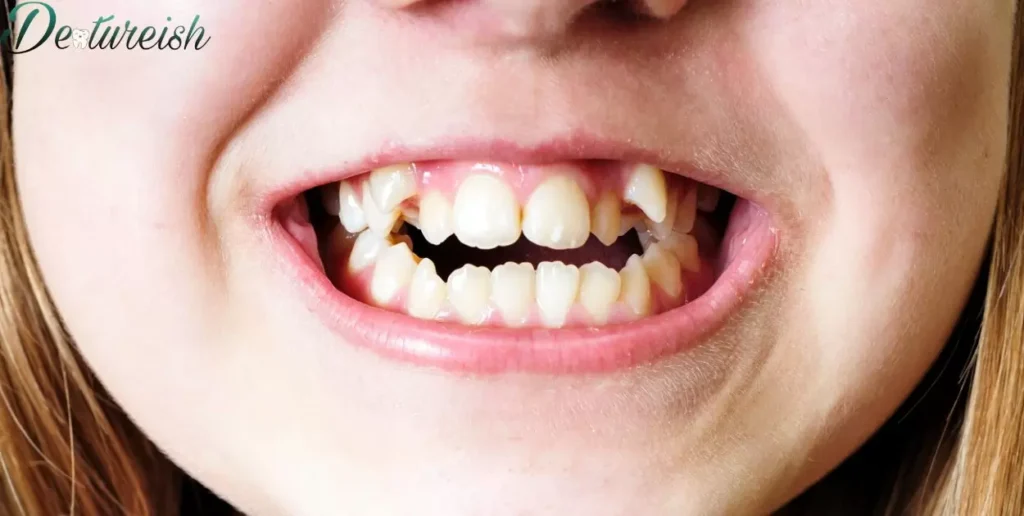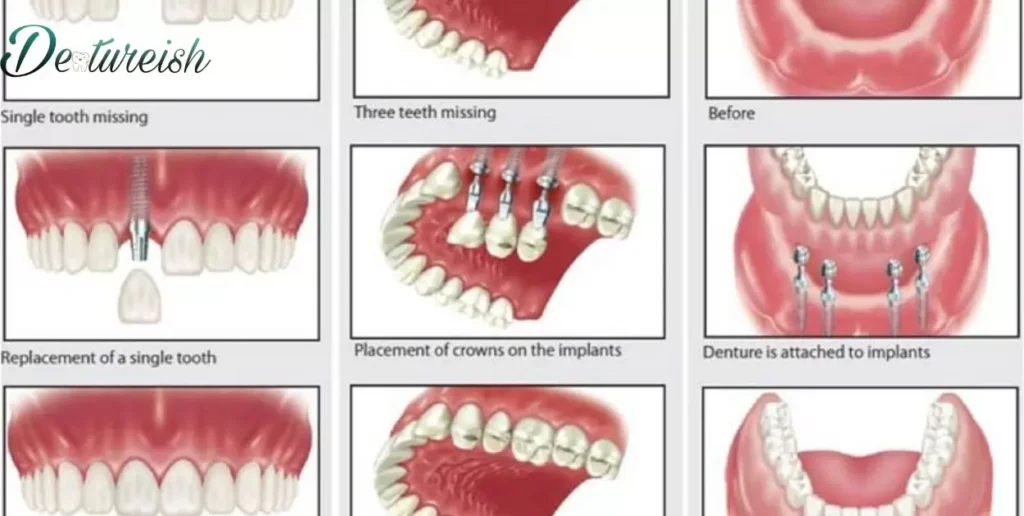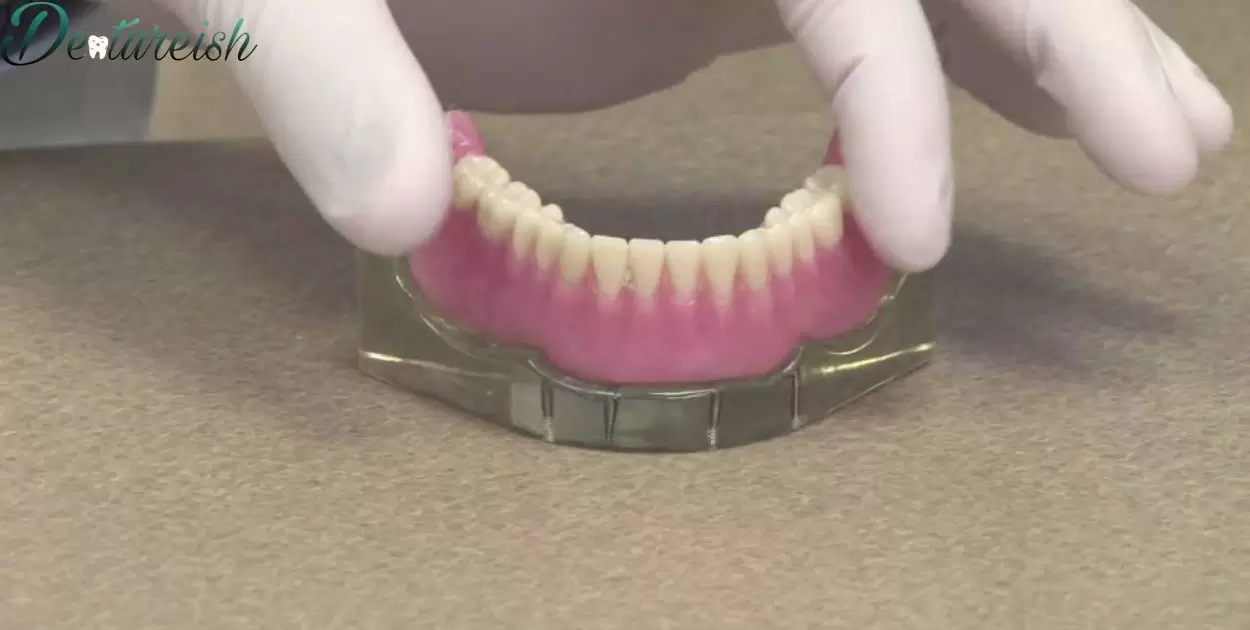“Partial denture stay in place” refers to a dental prosthesis designed to replace missing teeth while being securely held in position within the mouth. These removable devices use clasps or attachments to anchor onto existing natural teeth, providing functional support and restoring aesthetics for individuals with partial tooth loss.
Discover the secret to confident smiles! Ever wondered, ‘How does a partial denture stay in place?’ Uncover the answer to a secure and natural fit that will revolutionize your dental experience. Embrace a life of comfort and self-assurance—explore the key to seamless denture stability today!
A partial denture stays in place through a combination of natural suction, clasps that grip onto existing teeth, and a snug fit against the gums. These factors work together to provide stability and comfort for individuals with missing teeth, allowing them to eat, speak, and smile with confidence.
How To Keep Dentures In Place Without Adhesive
Securing dentures without adhesive is simple. First, rinse your mouth with warm water to moisten it. Then, bite down gently on your dentures to ensure a snug fit. If needed, consider using a denture adhesive alternative, like denture cushions or strips, to enhance stability.
Practicing good oral hygiene is crucial. Clean your dentures regularly to prevent slippage caused by food particles. Moreover, schedule regular check-ups with your dentist to address any fit issues and ensure your dentures stay comfortably in place without relying on adhesives.
Components of a Partial Denture
A partial denture has three main components: the metal framework, acrylic base, and artificial teeth. The metal framework provides stability and support, ensuring the denture fits securely in the mouth. The acrylic base sits on the gums, offering a comfortable foundation, while the artificial teeth restore the natural appearance of the smile.
Patients benefit from partial dentures as they are removable and easily cleanable. Regular care, including brushing and soaking, helps maintain oral hygiene. Dentists customize these components to ensure a snug fit, allowing individuals to enjoy improved functionality and aesthetics with their partial dentures.
The Role of Framework in Stability
A framework plays a crucial role in ensuring the stability of partial dentures. It serves as the supportive structure that holds the artificial teeth securely in place. Dentists use various materials, such as metal or acrylic, to create durable frameworks tailored to the patient’s unique dental needs.
The framework’s design directly impacts the denture’s stability and comfort. Dentists carefully consider factors like fit and material selection to enhance both functionality and aesthetics. In summary, a well-designed framework is essential for the stability of partial dentures, providing patients with a reliable and comfortable solution for missing teeth.
Understanding Denture Base Materials
Denture base materials play a crucial role in the construction of dentures. These materials serve as the foundation that supports the artificial teeth and ensures a comfortable fit. Denture bases are commonly made from acrylic resins, which are lightweight and durable, providing a balance between strength and flexibility.
When selecting denture base materials, it’s essential to consider factors like patient comfort and stability. Acrylic resins offer advantages such as easy adjustment and repair. Understanding these materials helps dental professionals create dentures that not only look natural but also provide optimal function and comfort for the wearer.
Precision Attachments Explained
Precision attachments enhance dentures by improving their stability and functionality. These attachments are small, custom-made devices that connect dentures to natural teeth or implants. Dentists use precision attachments to create a secure fit, allowing wearers to confidently eat and speak without worrying about denture movement.
Unlike traditional methods, precision attachments offer a more natural feel and appearance, ensuring a comfortable experience for denture wearers. These attachments provide a reliable solution for those seeking enhanced denture performance, offering a practical and efficient way to improve overall oral function.
Clasps and Their Impact on Retention
Clasps play a crucial role in dentures, enhancing their retention. These small, resilient components, usually made of metal, securely grasp onto natural teeth, preventing the denture from slipping or dislodging during daily activities. The effectiveness of clasps directly influences the overall stability and comfort of the denture, ensuring a more reliable and functional fit for the wearer.
In terms of impact, well-designed clasps contribute significantly to patient satisfaction by promoting confidence in denture use. The proper functioning of clasps allows individuals to eat, speak, and engage in social activities without the worry of their dentures shifting.
Anchoring to Natural Teeth
When anchoring to natural teeth, dentists use strong materials like metal or ceramic. These materials create a durable connection between artificial dental elements and existing teeth. This method ensures stability and functionality for the patient, promoting a natural feel and appearance.

The process involves attaching the dental prosthetic directly to the healthy natural teeth. This not only provides a secure foundation but also allows for effective chewing and speaking. Overall, anchoring to natural teeth is a common and reliable approach in modern dentistry, enhancing both the form and function of a patient’s smile.
Implant-Supported Partial Dentures
Implant-supported partial dentures are a modern solution for individuals with missing teeth. Dentists use small titanium implants that fuse with the jawbone to provide a stable foundation. These dentures offer improved stability and functionality compared to traditional options.
Patients experience enhanced comfort and confidence when wearing implant-supported partial dentures. The secure fit ensures a natural feel while eating or speaking, making them a popular choice for those seeking a reliable and durable tooth replacement option.
Pictures Of Partial Dentures Front Teeth
Partial dentures for front teeth provide a practical solution for those with missing teeth. These dental appliances are custom-made to seamlessly blend with your natural teeth, enhancing your smile. The pictures of partial dentures showcase their design and functionality, offering a clear visual guide for individuals considering this dental option.
In these images, you can see the careful craftsmanship that goes into creating partial dentures for front teeth. The photos highlight the realistic appearance of these prosthetics, ensuring a natural look that boosts confidence.
Dental Adhesives and Their Use
Dental adhesives are crucial in dentistry. Dentists use these adhesives to bond materials like crowns and veneers to teeth. Patients benefit from the strong bond, ensuring dental restorations stay securely in place. The adhesive application is a quick and painless part of many dental procedures, enhancing overall oral health.
- Secure Bonding: Dental adhesives create a strong bond between dental restorations like crowns and natural teeth, ensuring a secure fit.
- Painless Application: Dentists use dental adhesives in various procedures, and the application is quick and painless, enhancing the overall dental experience for patients.
- Stability for Restorations: Thanks to dental adhesives, restorations like veneers remain stable, providing long-lasting results and improved oral health.
- Essential Dentistry Tool: Dental adhesives play a crucial role in modern dentistry, contributing to the success and longevity of various dental treatments.
- Enhancing Oral Health: With the help of dental adhesives, patients can enjoy improved oral health by ensuring the reliability and stability of dental restorations.
Maintenance Tips for Stability
To keep your dentures stable, clean them daily with a soft brush and mild soap. Regular brushing removes food particles and prevents bacteria buildup. Soaking dentures overnight in a denture cleaner helps maintain their stability and keeps them fresh.
Avoid using hot water, as it can warp the dentures. Additionally, visit your dentist for regular check-ups to ensure a proper fit and address any issues promptly. Following these maintenance tips will help you enjoy stable and comfortable dentures for a longer period.
Challenges in Denture Stability
Denture stability poses challenges for many individuals. Ill-fitting dentures can lead to discomfort and difficulty in chewing. Denture wearers often face the constant struggle of maintaining stability, impacting their daily activities and overall quality of life.
One main challenge arises from changes in jawbone structure over time, affecting denture fit. To address this, regular check-ups with a dentist are crucial for adjustments. Another challenge stems from variations in individual oral anatomy, making it essential for dentists to tailor solutions that enhance denture stability. This keyword is particularly important when considering the longevity and effectiveness of dentures.
Adjustments and Relining for Improved Fit
Getting a better-fitting denture involves adjustments and relining. Dentists make precise modifications to the denture to enhance its fit. This process ensures comfort and stability, allowing individuals to confidently go about their daily activities.
Regular adjustments and relining are crucial for maintaining an optimal denture fit. As the jawbone changes over time, these modifications help keep the denture snug and functional. By addressing fit issues promptly, individuals can enjoy improved comfort and better oral function with their dentures.
Patient Education on Oral Care
Denture care is essential for maintaining oral health. Patients should clean their dentures daily using a soft brush and mild soap to remove plaque and food particles. Regular check-ups with the dentist help ensure proper fit and identify any issues early on.
Patient education plays a crucial role in promoting good oral hygiene with dentures. Dentists advise patients to avoid using abrasive materials and hot water, as these can damage dentures. By following these simple steps and staying informed, individuals can enjoy a healthy and comfortable experience with their dentures.
What Does A Single Tooth Denture Look Like
A single tooth denture is a replacement for a missing tooth. It is a small, custom-made prosthetic that mimics the appearance and function of a natural tooth. Dentures can be made from various materials, such as acrylic or metal, and are designed to match the color and shape of the surrounding teeth.

Typically, a single tooth denture consists of a crown attached to a base that fits snugly against the gums. The crown is crafted to blend seamlessly with the existing teeth, ensuring a natural-looking smile. These dentures offer a practical solution for individuals who have lost a single tooth, providing both aesthetic improvement and functional support for chewing and speaking.
Impact of Bone and Gum Health
Good bone and gum health play a crucial role in overall well-being. Strong bones support teeth, preventing issues like tooth loss. Healthy gums reduce the risk of gum disease, promoting a confident smile and good oral hygiene.
Regular dental check-ups and proper oral care, including brushing and flossing, are essential for maintaining strong bones and gums. Neglecting oral health may lead to complications, affecting not only the mouth but also impacting the entire body. Prioritizing bone and gum health contributes to a happier, healthier life.
Comparing Removable vs. Fixed Partial Dentures
Below is a simple table comparing removable and fixed partial dentures based on key features:
| Feature | Removable Partial Dentures | Fixed Partial Dentures |
| Attachment | Attached with clasps or clips | Cemented or bonded to adjacent teeth |
| Removability | Can be taken out by the wearer | Permanently fixed, not removable |
| Comfort | May feel bulkier and less secure | Generally more comfortable and stable |
| Maintenance | Requires regular removal for cleaning | Cleaned along with natural teeth |
| Speech Impact | May affect speech initially | Minimal impact on speech |
| Cost | Typically more affordable | Generally more expensive upfront |
| Aesthetics | Visible clasps may be noticeable | More natural-looking appearance |
| Bone Preservation | May contribute to bone loss | Helps preserve adjacent tooth structure |
| Treatment Time | Faster and simpler process | May take longer for fabrication and placement |
| Suitability for Jaw Health | May cause irritation or pressure points | Lesser impact on jaw health |
Individual preferences and specific dental needs may influence the choice between removable and fixed partial dentures. It’s advisable to consult with a dentist to determine the most suitable option based on your oral health and lifestyle.
Speech and Eating Considerations
When wearing dentures, it’s crucial to pay attention to speech and eating considerations. Dentures may affect speech initially, but with practice, clarity improves. Chewing can also feel different, so start with softer foods and gradually transition to a regular diet for better comfort.
Regular dental check-ups help ensure that dentures fit well, reducing speech and eating challenges. Properly fitting dentures enhance confidence in communication and make eating an enjoyable experience. Taking care of dentures and maintaining oral hygiene contributes to overall well-being.
Partial Dentures For Back Teeth On One Side
When you’re missing back teeth on one side, partial dentures offer a practical solution. These removable dental appliances fill the gaps, improving chewing and restoring your smile. Dentists customize partial dentures to match your natural teeth, ensuring a comfortable fit and seamless appearance.
Partial dentures for back teeth on one side are made from durable materials for long-lasting use. They provide both functional and aesthetic benefits, enhancing your ability to eat comfortably and boosting your confidence in social situations.
Common Issues with Partial Denture Stability
- Improved Chewing Confidence: Addressing common issues with partial denture stability ensures better stability during chewing. This enhances your confidence when eating various foods, promoting a more comfortable and enjoyable dining experience.
- Enhanced Speech Comfort: Stability issues with partial dentures can affect speech. By resolving these issues, you can speak more clearly and comfortably, without concerns about the dentures slipping or causing speech difficulties.
- Reduced Discomfort and Irritation: Addressing stability concerns helps minimize discomfort and irritation associated with ill-fitting partial dentures. Well-fitted dentures reduce the risk of sore spots or friction, enhancing overall oral comfort.
- Natural-Looking Smile: Stable partial dentures contribute to a more natural-looking smile. When properly secured, they blend seamlessly with your natural teeth, boosting aesthetic appeal and confidence in your appearance.
- Long-Term Oral Health: Resolving stability issues with partial dentures contributes to long-term oral health. A well-fitted denture reduces the risk of complications such as gum irritation or changes in bite alignment, supporting overall oral well-being. Regular check-ups with your dentist ensure that any stability issues are promptly addressed for sustained oral health.
Advancements in Denture Technology
Denture technology has made significant strides in recent years. Modern advancements focus on enhancing comfort and functionality for users. Innovations in materials and design have led to more natural-looking and durable dentures.
One notable breakthrough is the use of digital technology in denture fabrication. Computer-aided design and manufacturing (CAD/CAM) techniques allow for precise customization, ensuring a better fit and improved overall performance. As a result, individuals with dentures now experience increased satisfaction and confidence in their daily lives.
How To Adjust Partial Dentures At Home
Adjusting partial dentures at home is simple and can improve comfort. Start by removing the dentures and identifying sore spots or areas causing discomfort. Gently use a nail file to smooth any rough edges, ensuring a better fit. Repeat the process gradually until the dentures feel snug without causing pain.
For a more customized fit, consider using an over-the-counter denture adjustment kit. Follow the kit instructions carefully, making small adjustments at a time. Remember, seeking professional assistance is always advisable if the discomfort persists or if major adjustments are needed. Adjusting partial dentures at home can enhance your comfort and overall satisfaction with your dental appliances.
Frequently Asked Question
How well do partial dentures stay in?
Partial dentures generally stay in well when properly fitted and maintained. Good oral hygiene and regular check-ups with a dentist help ensure their stability.
Can a partial denture fall out?
Yes, a partial denture can fall out, especially if it doesn’t fit properly or if adhesive isn’t used. Regular check-ups with a dentist ensure a secure fit and prevent accidental displacement.
How do I stop my partials from falling out?
To prevent partials from falling out, ensure a proper fit by consulting your dentist for adjustments. Additionally, use a denture adhesive for added stability.
Do partial dentures move when eating?
Yes, partial dentures may move slightly while eating, especially if they don’t fit snugly. Ensuring a proper fit through adjustments can minimize movement and enhance stability during meals.
Conclusion
The stability of a partial denture is crucial for comfort and functionality. By understanding how a partial denture stays in place, individuals can take steps to ensure a secure fit.
Regular adjustments and proper care play key roles in maintaining the stability of partial dentures, providing users with confidence and ease in their daily activities. The proper alignment of the partial denture with the natural contours of the mouth contributes significantly to its stability.
The use of adhesives and seeking professional guidance for adjustments further reinforces the denture’s ability to stay securely in place. Ultimately, a well-fitted partial denture enhances the overall experience for individuals, allowing them to enjoy a more comfortable and functional oral health solution.

